Abstract
Biodegradability of commercial polychlorobiphenyl mixtures (Kaneclors, KC 200 to KC 500) and their metabolic products by Acinetobacter sp. strain P6 were studied by gas chromatography-mass spectrometry analysis. KC 200 (primarily dichlorobiphenyls) rapidly degraded after 4 h of incubation with the P6 resting cells, showing predominant accumulation of monochlorobenzoic acids. KC 300 (primarily trichlorobiphenyls) were also degraded after 4 h of incubation, producing various metabolic intermediates such as mono- and dichlorobenzoic acids, dihydroxy biphenyl compounds with two and three chlorines, and the ring meta-cleavage compounds with two and three chlorines. KC 400 (primarily tetrachlorobiphenyls) were also susceptible to biodegradation by the same organism. Chlorobenzoic acids (chlorine number 1 to 3), dihydroxy compounds (chlorine number 2 to 4), and the ring meta-cleavage compounds (chlorine number 2 to 3) were observed as the products from KC 400. In addition to such products, a large amount of unknown compounds with two chlorines in the molecule, which can be derived from 2,3,2',3' - or 2,3,2',5'-tetrachlorobiphenyls or both, accumulated. In contrast to KC 200, KC 300, and KC 400, KC 500 (primarily pentachlorobiphenyls) were resistant to degradation and hardly metabolized. Only dihydroxy compounds of certain pentachlorobiphenyls were detected.
Full text
PDF
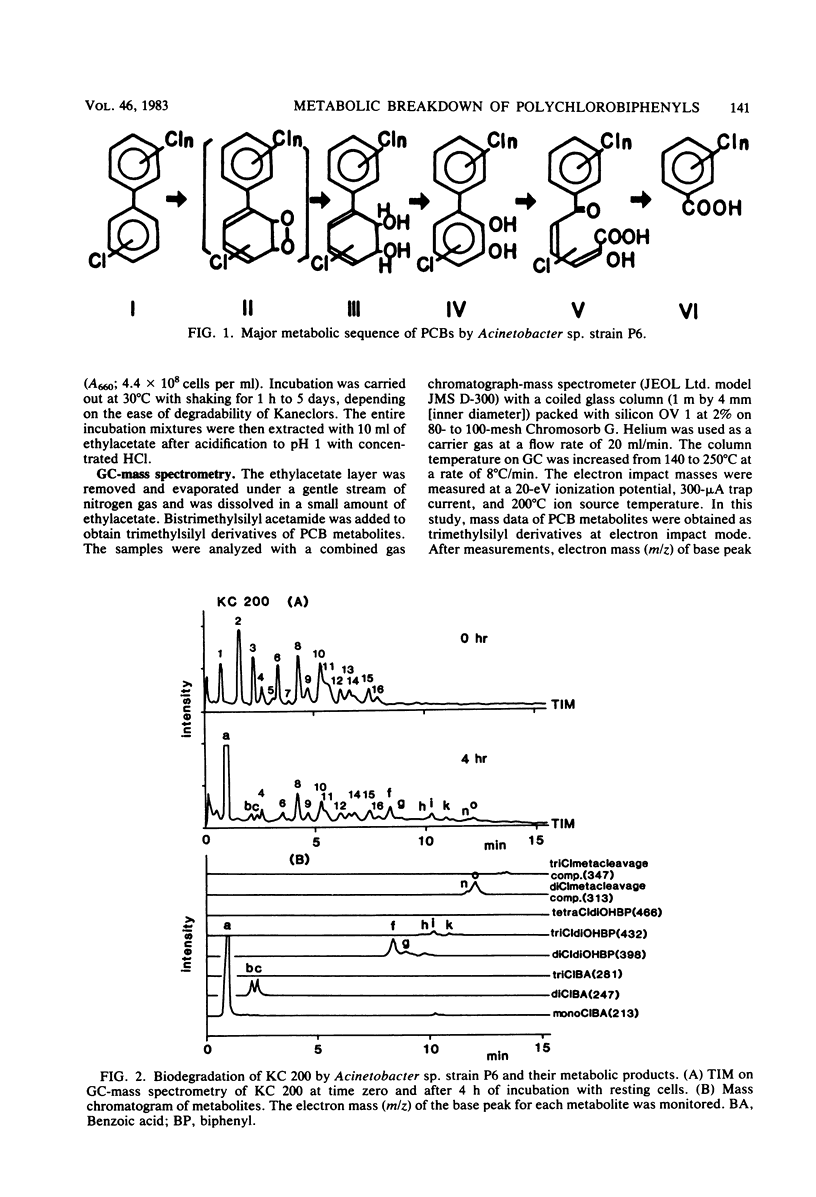
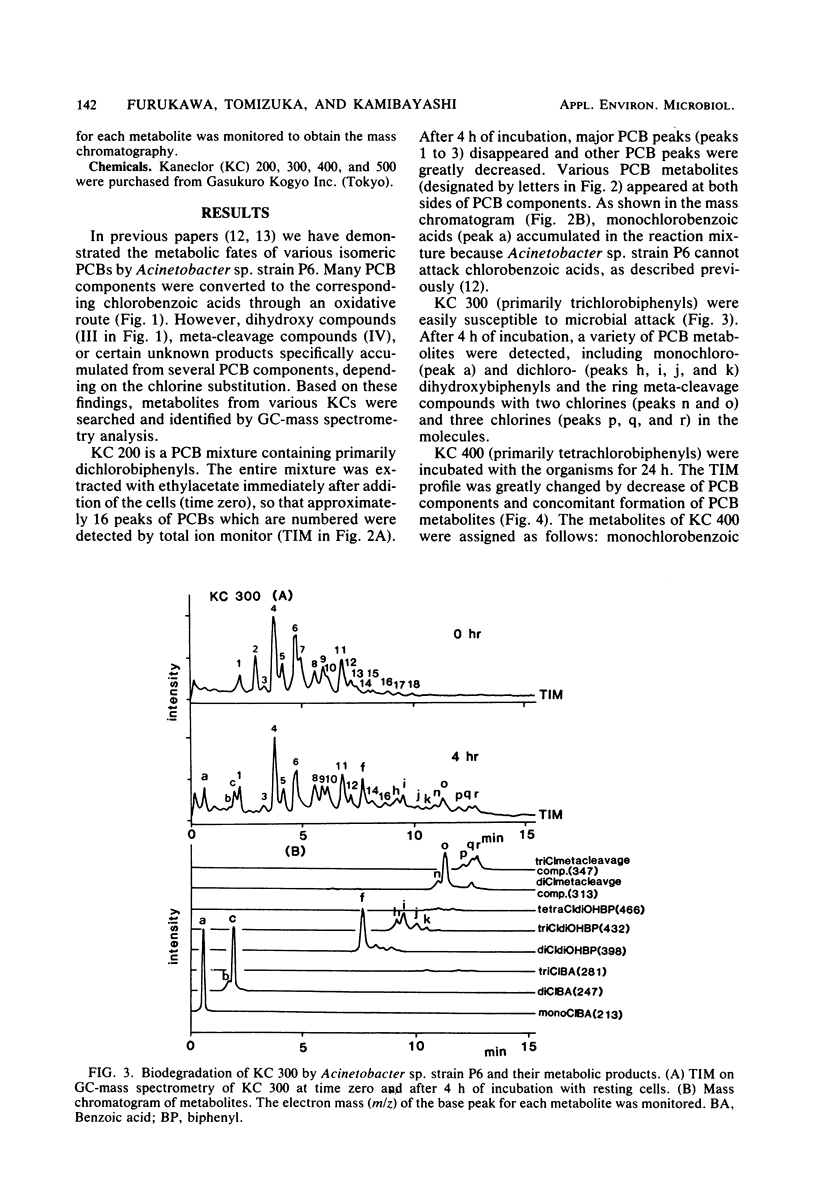
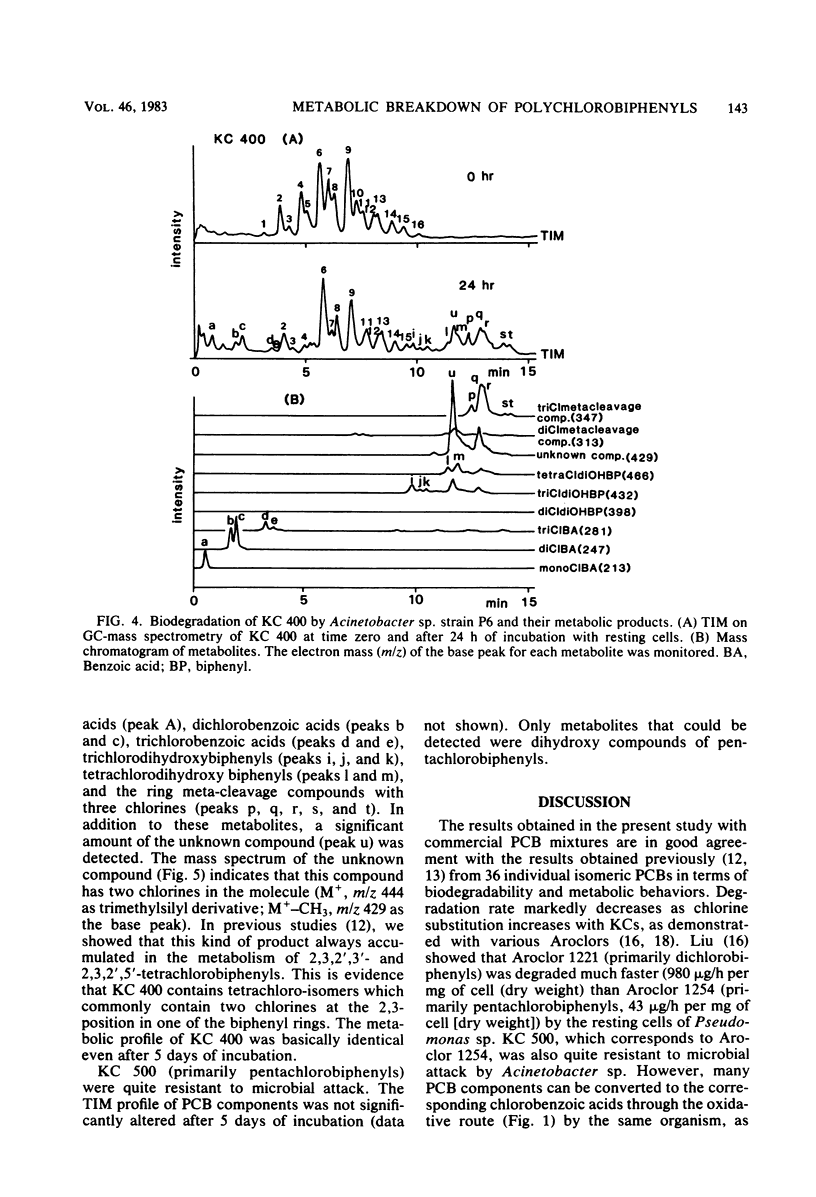
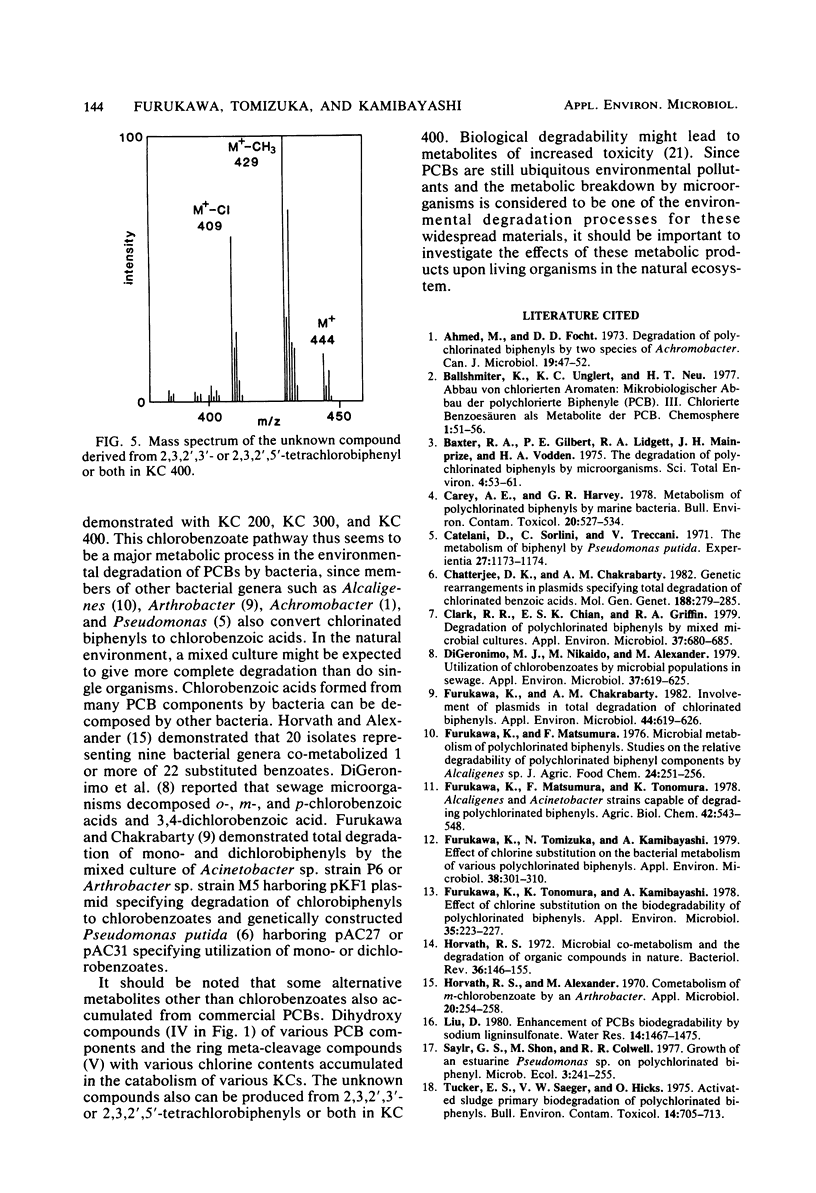
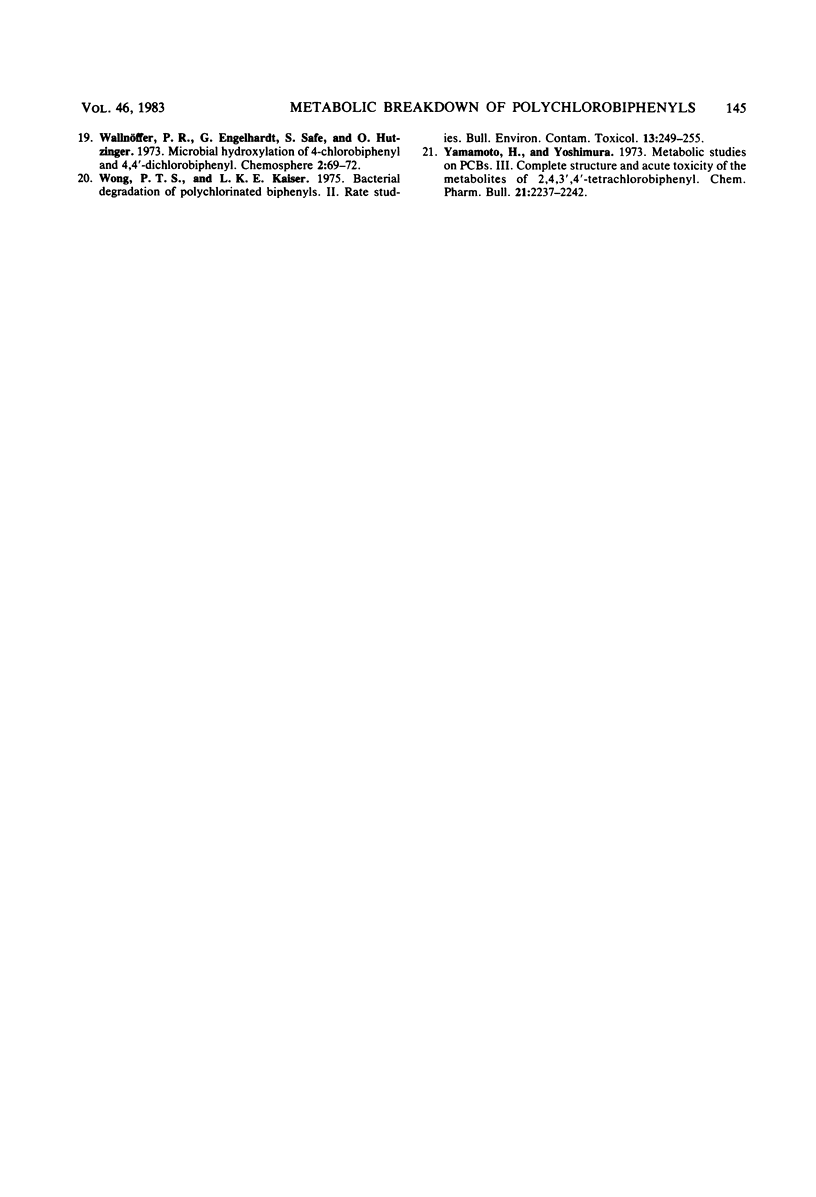
Selected References
These references are in PubMed. This may not be the complete list of references from this article.
- Ahmed M., Focht D. D. Degradation of polychlorinated biphenyls by two species of Achromobacter. Can J Microbiol. 1973 Jan;19(1):47–52. doi: 10.1139/m73-007. [DOI] [PubMed] [Google Scholar]
- Baxter R. A., Gilbert P. E., Lidgett R. A., Mainprize J. H., Vodden H. A. The degradation of polychlorinated biphenyls by micro-organisms. Sci Total Environ. 1975 May;4(1):53–61. doi: 10.1016/0048-9697(75)90014-5. [DOI] [PubMed] [Google Scholar]
- Carey A. E., Harvey G. R. Metabolism of polychlorinated biphenyls by marine bacteria. Bull Environ Contam Toxicol. 1978 Oct;20(4):527–534. doi: 10.1007/BF01683559. [DOI] [PubMed] [Google Scholar]
- Catelani D., Sorlini C., Treccani V. The metabolism of biphenyl by Pseudomonas putida. Experientia. 1971 Oct 15;27(10):1173–1174. doi: 10.1007/BF02286908. [DOI] [PubMed] [Google Scholar]
- Chatterjee D. K., Chakrabarty A. M. Genetic rearrangements in plasmids specifying total degradation of chlorinated benzoic acids. Mol Gen Genet. 1982;188(2):279–285. doi: 10.1007/BF00332688. [DOI] [PubMed] [Google Scholar]
- Clark R. R., Chian E. S., Griffin R. A. Degradation of polychlorinated biphenyls by mixed microbial cultures. Appl Environ Microbiol. 1979 Apr;37(4):680–685. doi: 10.1128/aem.37.4.680-685.1979. [DOI] [PMC free article] [PubMed] [Google Scholar]
- DiGeronimo M. J., Nikaido M., Alexander M. Utilization of chlorobenzoates by microbial populations in sewage. Appl Environ Microbiol. 1979 Mar;37(3):619–625. doi: 10.1128/aem.37.3.619-625.1979. [DOI] [PMC free article] [PubMed] [Google Scholar]
- Furukawa K., Chakrabarty A. M. Involvement of plasmids in total degradation of chlorinated biphenyls. Appl Environ Microbiol. 1982 Sep;44(3):619–626. doi: 10.1128/aem.44.3.619-626.1982. [DOI] [PMC free article] [PubMed] [Google Scholar]
- Furukawa K., Matsumura F. Microbial metabolism of polychlorinated biphenyls. Studies on the relative degradability of polychlorinated biphenyl components by Alkaligenes sp. J Agric Food Chem. 1976 Mar-Apr;24(2):251–256. doi: 10.1021/jf60204a002. [DOI] [PubMed] [Google Scholar]
- Furukawa K., Tomizuka N., Kamibayashi A. Effect of chlorine substitution on the bacterial metabolism of various polychlorinated biphenyls. Appl Environ Microbiol. 1979 Aug;38(2):301–310. doi: 10.1128/aem.38.2.301-310.1979. [DOI] [PMC free article] [PubMed] [Google Scholar]
- Furukawa K., Tonomura K., Kamibayashi A. Effect of chlorine substitution on the biodegradability of polychlorinated biphenyls. Appl Environ Microbiol. 1978 Feb;35(2):223–227. doi: 10.1128/aem.35.2.223-227.1978. [DOI] [PMC free article] [PubMed] [Google Scholar]
- Horvath R. S., Alexander M. Cometabolism of m-chlorobenzoate by an Arthrobacter. Appl Microbiol. 1970 Aug;20(2):254–258. doi: 10.1128/am.20.2.254-258.1970. [DOI] [PMC free article] [PubMed] [Google Scholar]
- Horvath R. S. Microbial co-metabolism and the degradation of organic compounds in nature. Bacteriol Rev. 1972 Jun;36(2):146–155. doi: 10.1128/br.36.2.146-155.1972. [DOI] [PMC free article] [PubMed] [Google Scholar]
- Kutsuna M., Someda K., Morita K., Yamanouchi Y., Kurimoto T., Kawamura Y., Matsumura H. [Ischemic cerebral symptoms after subarachnoid hemorrhage due to aneurysmal rupture (author's transl)]. No Shinkei Geka. 1978 Jun;6(6):543–548. [PubMed] [Google Scholar]
- Tucker E. S., Saeger V. W., Hicks O. Activated sludge primary biodegradation of polychlorinated biphenyls. Bull Environ Contam Toxicol. 1975 Dec;14(6):705–713. doi: 10.1007/BF01685246. [DOI] [PubMed] [Google Scholar]
- Wong P. T., Kaiser K. L. Bacterial degradation of polychlorinated biphenyls II. Rate studies. Bull Environ Contam Toxicol. 1975 Feb;13(2):249–255. doi: 10.1007/BF01721747. [DOI] [PubMed] [Google Scholar]
- Yamamoto H., Yoshimura H. Metabolic studies on polychlorinated biphenyls. 3. Complete structure and acute toxicity of the metabolites of 2,4,3',4'-tetrachlorobiphenyl. Chem Pharm Bull (Tokyo) 1973 Oct;21(10):2237–2242. doi: 10.1248/cpb.21.2237. [DOI] [PubMed] [Google Scholar]


